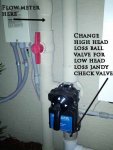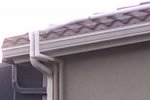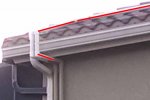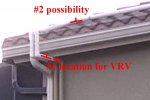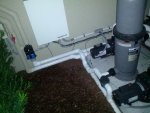- Feb 27, 2010
- 86
- Pool Size
- 18300
- Surface
- Plaster
- Chlorine
- Salt Water Generator
- SWG Type
- Jandy Truclear / Ei
Thanks to you all for all the help with the issues I had getting my nine Heliocol HC-50 solar panels to work:
http://www.troublefreepool.com/pump-power-w-different-impellers-2-speed-vs-vs-w-solar-t70827.html
Unfortunately as time went on, I found out that my installer knew less and less about solar. At this point I'm on my own in terms of trying to fix the small things. Hopefully I never need any warranty repairs from them...
One of the things they didn't install was a vacuum release valve. I asked the owner, and he said they're "not needed in this climate" in South Florida. His tech doesn't know how to adjust the valves on a solar system with a split after the filter to get water up to the solar panels, and he didn't install a check valve on the outflow, so I don't believe his answers. I think he may have been confused with a drain valve used in freezing weather.
Anyway, from what I've read here, everyone recommended a vacuum release valve to
1) prevent collapse of the panels from negative pressure
2) prevent overheating of the PVC pipes from the heating of stagnant water in the pipes
3) prevent cooling of water in the solar panels overnight from convection on cool nights, and that water then being returned to the pool in the morning
The opinions here on location for a vacuum release valve (VRV) vary from
1) the solar inflow pipe past the solar valve above the height of the pool level, for easy access
2) the top of the panels
3) anywhere in between
I don't know if location matters based on the height of my panels or whether I'm in a freezing-prone area, which I'm not.
The bottom of my panels are around 23' above the pool level.
I will be having to tell someone who might know about plumbing/pools where to install the VRV, but unfortunately they probably won't know anything about adjusting them, etc. If I have to install it on my roof, then i need someone who can get up a 23' roof, and then I won't be able to get up there to adjust them, which I currently don't know how to do anyway.
What do you recommend in terms of
1) location of installation
2) brand/type of VRV to install
Also, I'm also going to have the ball check valve they installed below the solar 3-way valve changed for a lower-head Jandy:
http://www.zodiacpoolsystems.com/Products/Valves/Check-Valve.aspx
I have 2" PVC pipes. They list one size:
7235 Jandy Pro Series 180Degree, 1 1/2" - 2" Check Valve
and another:
7305 Jandy Pro Series 180Degree, 2" - 21/2" Check Valve
both overlap at 2". Should I get the bigger or the smaller one?
They also didn't install a check valve on the outflow. I was going to have a FloVis flow meter installed on the outflow near where shown in the picture below, above the red manual valve they installed on the outflow. My question was - the reason that I was recommended by people here to put the check valve was to prevent back flow into the outflow pipes that could go up into the panels, which could lead to the problems #2 & 3 in my list above as to why I think I need a vacuum release valve. However, I have a 2-speed 2.0 HP pump, and when solar is off, unless my pool feature is on, which is maybe 10 minutes a day, the pump is always in low-speed mode. This should not be able to generate enough head to get any water into my panels, I don't think, and with a VRV, the panels should drain. Given the extra head that the outflow VRV will give me, do I really need an outflow pipe check valve? If not, where would I put my FloVis flow meter? I think it couldn't be instead of the check valve I need to change, since that's before the solar valve.
Also, if anyone know someone in South Florida who knows about solar stuff that I could contract to do these changes, that would be appreciated. I know it's simple plumbing for most of you, but otherwise I'll probably get my pool guy or one my pool installation contractor's guys, who don't know about solar, to help with these things.
Thanks!
http://www.troublefreepool.com/pump-power-w-different-impellers-2-speed-vs-vs-w-solar-t70827.html
Unfortunately as time went on, I found out that my installer knew less and less about solar. At this point I'm on my own in terms of trying to fix the small things. Hopefully I never need any warranty repairs from them...
One of the things they didn't install was a vacuum release valve. I asked the owner, and he said they're "not needed in this climate" in South Florida. His tech doesn't know how to adjust the valves on a solar system with a split after the filter to get water up to the solar panels, and he didn't install a check valve on the outflow, so I don't believe his answers. I think he may have been confused with a drain valve used in freezing weather.
Anyway, from what I've read here, everyone recommended a vacuum release valve to
1) prevent collapse of the panels from negative pressure
2) prevent overheating of the PVC pipes from the heating of stagnant water in the pipes
3) prevent cooling of water in the solar panels overnight from convection on cool nights, and that water then being returned to the pool in the morning
The opinions here on location for a vacuum release valve (VRV) vary from
1) the solar inflow pipe past the solar valve above the height of the pool level, for easy access
2) the top of the panels
3) anywhere in between
I don't know if location matters based on the height of my panels or whether I'm in a freezing-prone area, which I'm not.
The bottom of my panels are around 23' above the pool level.
I will be having to tell someone who might know about plumbing/pools where to install the VRV, but unfortunately they probably won't know anything about adjusting them, etc. If I have to install it on my roof, then i need someone who can get up a 23' roof, and then I won't be able to get up there to adjust them, which I currently don't know how to do anyway.
What do you recommend in terms of
1) location of installation
2) brand/type of VRV to install
Also, I'm also going to have the ball check valve they installed below the solar 3-way valve changed for a lower-head Jandy:
http://www.zodiacpoolsystems.com/Products/Valves/Check-Valve.aspx
I have 2" PVC pipes. They list one size:
7235 Jandy Pro Series 180Degree, 1 1/2" - 2" Check Valve
and another:
7305 Jandy Pro Series 180Degree, 2" - 21/2" Check Valve
both overlap at 2". Should I get the bigger or the smaller one?
They also didn't install a check valve on the outflow. I was going to have a FloVis flow meter installed on the outflow near where shown in the picture below, above the red manual valve they installed on the outflow. My question was - the reason that I was recommended by people here to put the check valve was to prevent back flow into the outflow pipes that could go up into the panels, which could lead to the problems #2 & 3 in my list above as to why I think I need a vacuum release valve. However, I have a 2-speed 2.0 HP pump, and when solar is off, unless my pool feature is on, which is maybe 10 minutes a day, the pump is always in low-speed mode. This should not be able to generate enough head to get any water into my panels, I don't think, and with a VRV, the panels should drain. Given the extra head that the outflow VRV will give me, do I really need an outflow pipe check valve? If not, where would I put my FloVis flow meter? I think it couldn't be instead of the check valve I need to change, since that's before the solar valve.
Also, if anyone know someone in South Florida who knows about solar stuff that I could contract to do these changes, that would be appreciated. I know it's simple plumbing for most of you, but otherwise I'll probably get my pool guy or one my pool installation contractor's guys, who don't know about solar, to help with these things.
Thanks!


